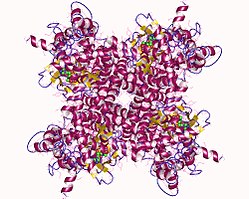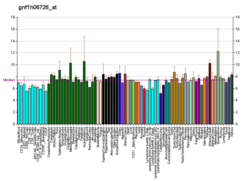Potassium/sodium hyperpolarization-activated cyclic nucleotide-gated channel 1 is a protein that in humans is encoded by the HCN1 gene.[5][6][7][8]
Function
editHyperpolarization-activated cation channels of the HCN gene family, such as HCN1, contribute to spontaneous rhythmic activity in both heart and brain.[8]
Tissue distribution
editHCN1 channel expression is found in the sinoatrial node,[9][10] the neocortex, hippocampus, cerebellar cortex, dorsal root ganglion, trigeminal ganglion and brainstem.[11][12][13][14][15]
Ligands
edit- Isoflurane and Sevoflurane inhibit HCN1.[19]
Interactions
editEpilepsy
editSee also
editReferences
edit- ^ a b c GRCh38: Ensembl release 89: ENSG00000164588 – Ensembl, May 2017
- ^ a b c GRCm38: Ensembl release 89: ENSMUSG00000021730 – Ensembl, May 2017
- ^ "Human PubMed Reference:". National Center for Biotechnology Information, U.S. National Library of Medicine.
- ^ "Mouse PubMed Reference:". National Center for Biotechnology Information, U.S. National Library of Medicine.
- ^ Santoro B, Grant SG, Bartsch D, Kandel ER (December 1997). "Interactive cloning with the SH3 domain of N-src identifies a new brain specific ion channel protein, with homology to eag and cyclic nucleotide-gated channels". Proceedings of the National Academy of Sciences of the United States of America. 94 (26): 14815–14820. Bibcode:1997PNAS...9414815S. doi:10.1073/pnas.94.26.14815. PMC 25120. PMID 9405696.
- ^ Santoro B, Liu DT, Yao H, Bartsch D, Kandel ER, Siegelbaum SA, Tibbs GR (May 1998). "Identification of a gene encoding a hyperpolarization-activated pacemaker channel of brain". Cell. 93 (5): 717–729. doi:10.1016/S0092-8674(00)81434-8. PMID 9630217.
- ^ Hofmann F, Biel M, Kaupp UB (December 2005). "International Union of Pharmacology. LI. Nomenclature and structure-function relationships of cyclic nucleotide-regulated channels". Pharmacological Reviews. 57 (4): 455–462. doi:10.1124/pr.57.4.8. PMID 16382102. S2CID 45853869.
- ^ a b "Entrez Gene: HCN1 hyperpolarization activated cyclic nucleotide-gated potassium channel 1".
- ^ Marionneau C, Couette B, Liu J, Li H, Mangoni ME, Nargeot J, et al. (January 2005). "Specific pattern of ionic channel gene expression associated with pacemaker activity in the mouse heart". The Journal of Physiology. 562 (Pt 1): 223–234. doi:10.1113/jphysiol.2004.074047. PMC 1665484. PMID 15498808.
- ^ Shi W, Wymore R, Yu H, Wu J, Wymore RT, Pan Z, et al. (July 1999). "Distribution and prevalence of hyperpolarization-activated cation channel (HCN) mRNA expression in cardiac tissues". Circulation Research. 85 (1): e1–e6. doi:10.1161/01.RES.85.1.e1. PMID 10400919.
- ^ Lörincz A, Notomi T, Tamás G, Shigemoto R, Nusser Z (November 2002). "Polarized and compartment-dependent distribution of HCN1 in pyramidal cell dendrites". Nature Neuroscience. 5 (11): 1185–1193. doi:10.1038/nn962. PMID 12389030. S2CID 18132966.
- ^ Milligan CJ, Edwards IJ, Deuchars J (April 2006). "HCN1 ion channel immunoreactivity in spinal cord and medulla oblongata". Brain Research. 1081 (1): 79–91. doi:10.1016/j.brainres.2006.01.019. PMID 16503331. S2CID 30929772.
- ^ Moosmang S, Biel M, Hofmann F, Ludwig A (1999). "Differential distribution of four hyperpolarization-activated cation channels in mouse brain". Biological Chemistry. 380 (7–8): 975–980. doi:10.1515/BC.1999.121. PMID 10494850. S2CID 22722872.
- ^ Wells JE, Rowland KC, Proctor EK (September 2007). "Hyperpolarization-activated channels in trigeminal ganglia innervating healthy and pulp-exposed teeth". International Endodontic Journal. 40 (9): 715–721. doi:10.1111/j.1365-2591.2007.01297.x. PMID 17645513.
- ^ Santoro B, Grant SG, Bartsch D, Kandel ER (December 1997). "Interactive cloning with the SH3 domain of N-src identifies a new brain specific ion channel protein, with homology to eag and cyclic nucleotide-gated channels". Proceedings of the National Academy of Sciences of the United States of America. 94 (26): 14815–14820. Bibcode:1997PNAS...9414815S. doi:10.1073/pnas.94.26.14815. PMC 25120. PMID 9405696.
- ^ Chen X, Shu S, Bayliss DA (January 2009). "HCN1 channel subunits are a molecular substrate for hypnotic actions of ketamine". The Journal of Neuroscience. 29 (3): 600–609. doi:10.1523/JNEUROSCI.3481-08.2009. PMC 2744993. PMID 19158287.
- ^ Zhou C, Douglas JE, Kumar NN, Shu S, Bayliss DA, Chen X (April 2013). "Forebrain HCN1 channels contribute to hypnotic actions of ketamine". Anesthesiology. 118 (4): 785–795. doi:10.1097/ALN.0b013e318287b7c8. PMC 3605219. PMID 23377220.
- ^ Bojak I, Day HC, Liley DT (2013). "Ketamine, Propofol, and the EEG: A Neural Field Analysis of HCN1-Mediated Interactions". Frontiers in Computational Neuroscience. 7: 22. doi:10.3389/fncom.2013.00022. PMC 3617565. PMID 23576979.
- ^ Zhou C, Liang P, Liu J, Ke B, Wang X, Li F, et al. (September 2015). "HCN1 Channels Contribute to the Effects of Amnesia and Hypnosis but not Immobility of Volatile Anesthetics". Anesthesia and Analgesia. 121 (3): 661–666. doi:10.1213/ANE.0000000000000830. PMC 4544830. PMID 26287296.
- ^ Much B, Wahl-Schott C, Zong X, Schneider A, Baumann L, Moosmang S, et al. (October 2003). "Role of subunit heteromerization and N-linked glycosylation in the formation of functional hyperpolarization-activated cyclic nucleotide-gated channels". The Journal of Biological Chemistry. 278 (44): 43781–43786. doi:10.1074/jbc.M306958200. PMID 12928435.
- ^ Proenza C, Tran N, Angoli D, Zahynacz K, Balcar P, Accili EA (August 2002). "Different roles for the cyclic nucleotide binding domain and amino terminus in assembly and expression of hyperpolarization-activated, cyclic nucleotide-gated channels". The Journal of Biological Chemistry. 277 (33): 29634–29642. doi:10.1074/jbc.M200504200. PMID 12034718.
- ^ Nava C, Dalle C, Rastetter A, Striano P, de Kovel CG, Nabbout R, et al. (June 2014). "De novo mutations in HCN1 cause early infantile epileptic encephalopathy" (PDF). Nature Genetics. 46 (6): 640–645. doi:10.1038/ng.2952. PMID 24747641. S2CID 861414.
Further reading
edit- Bonaldo MF, Lennon G, Soares MB (September 1996). "Normalization and subtraction: two approaches to facilitate gene discovery". Genome Research. 6 (9): 791–806. doi:10.1101/gr.6.9.791. PMID 8889548.
- Ludwig A, Zong X, Jeglitsch M, Hofmann F, Biel M (June 1998). "A family of hyperpolarization-activated mammalian cation channels". Nature. 393 (6685): 587–591. Bibcode:1998Natur.393..587L. doi:10.1038/31255. PMID 9634236. S2CID 4429453.
- Kleiderlein JJ, Nisson PE, Jessee J, Li WB, Becker KG, Derby ML, et al. (December 1998). "CCG repeats in cDNAs from human brain". Human Genetics. 103 (6): 666–673. doi:10.1007/s004390050889. PMID 9921901. S2CID 23696667.
- Ulens C, Tytgat J (March 2001). "Functional heteromerization of HCN1 and HCN2 pacemaker channels". The Journal of Biological Chemistry. 276 (9): 6069–6072. doi:10.1074/jbc.C000738200. PMID 11133998.
- Proenza C, Tran N, Angoli D, Zahynacz K, Balcar P, Accili EA (August 2002). "Different roles for the cyclic nucleotide binding domain and amino terminus in assembly and expression of hyperpolarization-activated, cyclic nucleotide-gated channels". The Journal of Biological Chemistry. 277 (33): 29634–29642. doi:10.1074/jbc.M200504200. PMID 12034718.
- Chaplan SR, Guo HQ, Lee DH, Luo L, Liu C, Kuei C, et al. (February 2003). "Neuronal hyperpolarization-activated pacemaker channels drive neuropathic pain". The Journal of Neuroscience. 23 (4): 1169–1178. doi:10.1523/JNEUROSCI.23-04-01169.2003. PMC 6742242. PMID 12598605.
- Lesso H, Li RA (June 2003). "Helical secondary structure of the external S3-S4 linker of pacemaker (HCN) channels revealed by site-dependent perturbations of activation phenotype". The Journal of Biological Chemistry. 278 (25): 22290–22297. doi:10.1074/jbc.M302466200. PMID 12668666.
- Bender RA, Soleymani SV, Brewster AL, Nguyen ST, Beck H, Mathern GW, Baram TZ (July 2003). "Enhanced expression of a specific hyperpolarization-activated cyclic nucleotide-gated cation channel (HCN) in surviving dentate gyrus granule cells of human and experimental epileptic hippocampus". The Journal of Neuroscience. 23 (17): 6826–6836. doi:10.1523/JNEUROSCI.23-17-06826.2003. PMC 3100807. PMID 12890777.
- Much B, Wahl-Schott C, Zong X, Schneider A, Baumann L, Moosmang S, et al. (October 2003). "Role of subunit heteromerization and N-linked glycosylation in the formation of functional hyperpolarization-activated cyclic nucleotide-gated channels". The Journal of Biological Chemistry. 278 (44): 43781–43786. doi:10.1074/jbc.M306958200. PMID 12928435.
- He C, Chen F, Li B, Hu Z (January 2014). "Neurophysiology of HCN channels: from cellular functions to multiple regulations". Progress in Neurobiology. 112: 1–23. doi:10.1016/j.pneurobio.2013.10.001. PMID 24184323. S2CID 37519503.
- Wahl-Schott C, Fenske S, Biel M (April 2014). "HCN channels: new roles in sinoatrial node function". Current Opinion in Pharmacology. 15: 83–90. doi:10.1016/j.coph.2013.12.005. PMID 24441197.
External links
edit- HCN1+protein,+human at the U.S. National Library of Medicine Medical Subject Headings (MeSH)
- Overview of all the structural information available in the PDB for UniProt: O60741 (Human Potassium/sodium hyperpolarization-activated cyclic nucleotide-gated channel 1) at the PDBe-KB.
- Overview of all the structural information available in the PDB for UniProt: O88704 (Mouse Potassium/sodium hyperpolarization-activated cyclic nucleotide-gated channel 1) at the PDBe-KB.
This article incorporates text from the United States National Library of Medicine, which is in the public domain.





